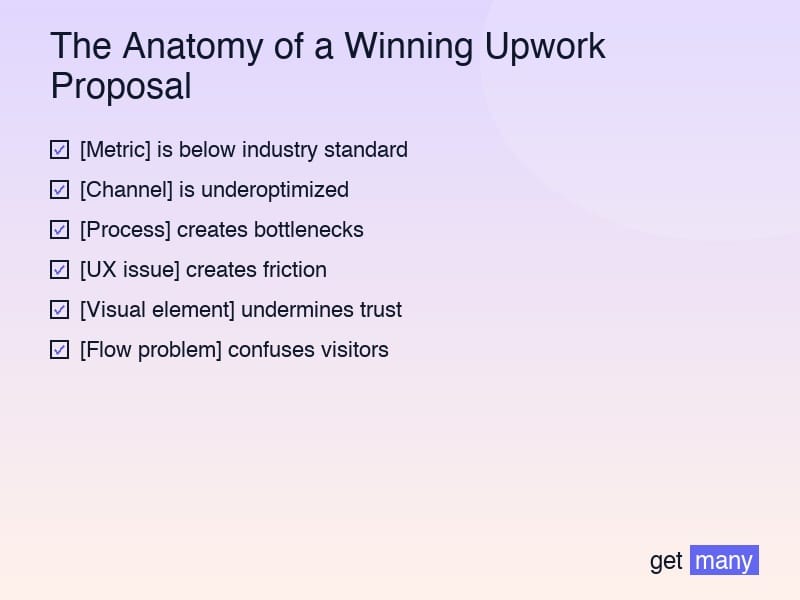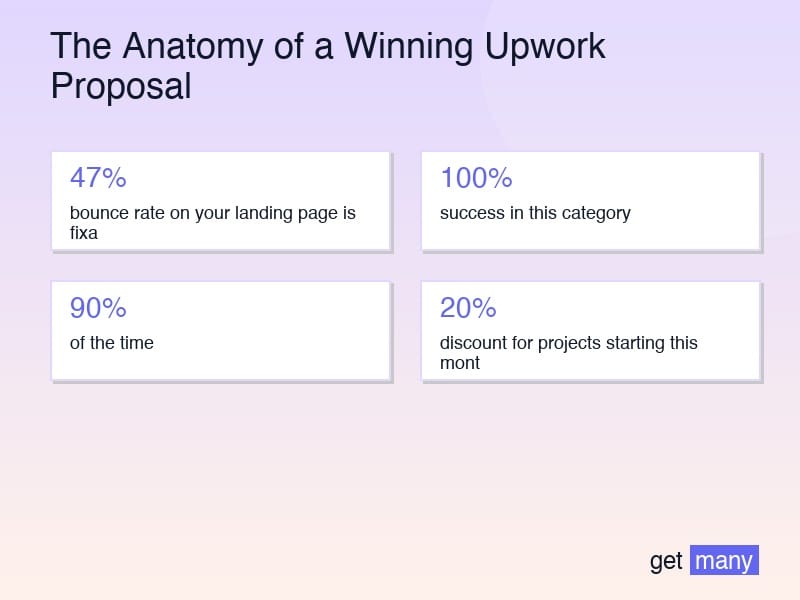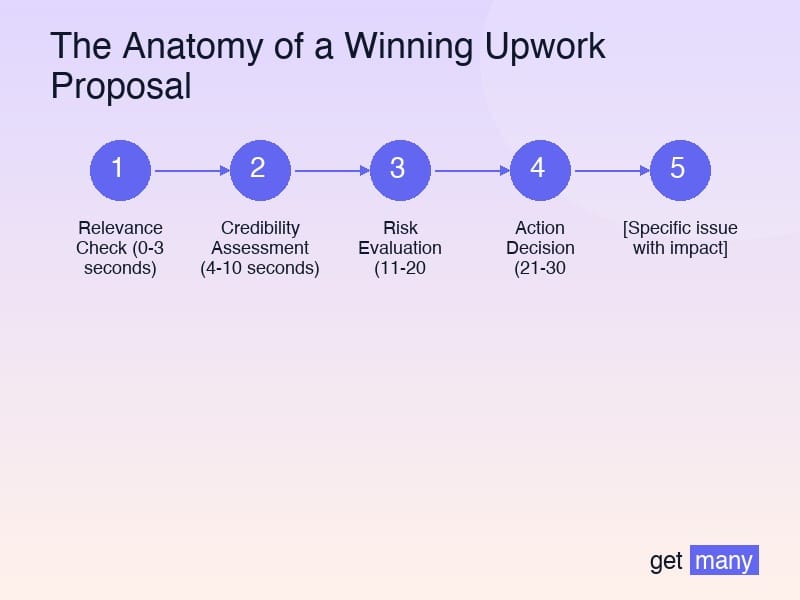3 August, 2025

Category
upwork-agencies
Author
Kyrylo Kozak
The Anatomy of a Winning Upwork Proposal
Three months ago, I split-tested 100 proposals using two different structures. Version A followed conventional wisdom - introduce yourself, list experience, describe services. It converted at 7%. Version B used the framework I'm about to share. It converted at 47%. Same projects, same rates, same portfolio - completely different results.
Your Upwork proposal is a precision sales instrument. Every element serves a specific psychological purpose, guiding prospects from skepticism to enthusiasm in under 60 seconds. Yet most agencies write proposals like casual emails, wondering why clients don't respond.
This guide dissects winning proposals line by line, revealing the neuroscience behind what makes clients click "hire" instead of "archive." Master this anatomy, and watch your win rate transform overnight.
The Neuroscience of Proposal Processing

Before crafting your proposal, understand how clients actually read them:
The 3-Second Scan Pattern
Eye-tracking studies show clients follow this pattern:
``` [First line - 100% attention] [Second line - 80% attention] [Third line - 60% attention] [SCANNING BEGINS] [Bold/formatted text only] [Numbers and metrics] [Final line check] [Decision: Read fully or skip] ```
Critical insight: Your first three lines determine whether the rest gets read at all.
The Decision Psychology
Clients make four micro-decisions while reading:
"Does this person understand my problem?"
- Relevance Check (0-3 seconds)
"Can they actually solve it?"
- Credibility Assessment (4-10 seconds)
"What could go wrong?"
- Risk Evaluation (11-20 seconds)
"Should I respond?"
- Action Decision (21-30 seconds)
Your proposal must nail all four decision points.
Component 1: The Hook (Lines 1-2)

The hook determines everything. Get it wrong, and nothing else matters.
Weak Hooks That Get Ignored
❌ "Hi, I read your job post and I'm interested..." ❌ "My name is John and I run an agency..." ❌ "I have 10 years of experience in..." ❌ "Thank you for posting this opportunity..." ❌ "I would love to help you with your project..."
These generic openings signal you're just another applicant.
Power Hooks That Demand Attention
✅ "I see you're losing $50K monthly to cart abandonment. Here's the exact fix we implemented for [Similar Client]..."
✅ "Your competitor just launched the feature you're building. Here's how to leapfrog them in 30 days..."
✅ "The 47% bounce rate on your landing page is fixable in one week. Let me show you how..."
✅ "I noticed three critical issues in your current implementation that are costing you customers..."
✅ "We just helped [Similar Company] achieve exactly what you're describing. Here's the playbook..."
The Hook Formula Matrix
Choose based on available information:
Formula 1: Problem + Solution + Proof "[Specific problem] + [Your solution] + [Similar result]"
Formula 2: Insight + Authority + Intrigue "[Unique observation] + [Why you know] + [What's possible]"
Formula 3: Result + Method + Timeline "[Outcome they want] + [How you'll deliver] + [When they'll see it]"
Component 2: The Diagnosis (Lines 3-8)

After hooking attention, demonstrate deep understanding:
The Diagnostic Framework
Surface Level (What everyone sees): "You need a new website"
Deeper Level (What good agencies see): "You need a website that converts visitors into customers"
Expert Level (What wins projects): "Your current site has three conversion killers: slow load time (8.2 seconds), unclear value proposition, and a broken mobile experience. This is costing you approximately 2,400 customers monthly based on your traffic."
Diagnosis Templates
For Technical Projects: "Based on your requirements, you're facing three technical challenges:
- [Specific issue with impact]
- [Related problem with cost]
- [Hidden issue they missed]
Here's how each affects your business..."
For Marketing Projects: "Your growth is stalling because:
- [Metric] is below industry standard
- [Channel] is underoptimized
- [Process] creates bottlenecks
Let me break down the fix..."
For Design Projects: "Users are leaving because:
- [UX issue] creates friction
- [Visual element] undermines trust
- [Flow problem] confuses visitors
Here's what's happening..."
Component 3: The Solution Architecture (Lines 9-15)
Present your approach with strategic clarity:
The Phased Approach Method
Phase Structure: ``` Phase 1: [Discovery/Audit] (Week 1)
- [Specific deliverable]
- [Key insight gained]
- [Foundation built]
Phase 2: [Implementation] (Weeks 2-3)
- [Core development]
- [Testing approach]
- [Progress milestones]
Phase 3: [Optimization] (Week 4)
- [Performance tuning]
- [Final adjustments]
- [Handoff preparation]
```
Solution Positioning Strategies
The Proprietary Method: "We'll apply our proven SCALE framework:
- S: Strategic audit
- C: Conversion optimization
- A: Automated systems
- L: Launch preparation
- E: Evolution planning"
The Results Roadmap: "Week 1: Identify all conversion leaks Week 2: Implement quick wins (expect 20% lift) Week 3: Deploy major optimizations Week 4: Test, refine, and document"
The Risk Mitigation Plan: "Our approach minimizes risk through:
- Staged deployment
- Continuous testing
- Rollback procedures
- Performance guarantees"
Component 4: The Proof Layer (Lines 16-20)
Evidence transforms interest into trust:
Proof Hierarchy (Most to Least Powerful)
"We did exactly this for [Similar Company], resulting in [Specific Metric]"
- Specific Similar Success
"Our last 5 similar projects averaged 234% ROI"
- Relevant Case Metrics
"Our approach won 'Best Practice' at [Industry Event]"
- Industry Recognition
"Top Rated Plus with 100% success in this category"
- Platform Credibility
"Certified in [Relevant Technology] with advanced specialization"
- Technical Certifications
Proof Presentation Formulas
The Triple Threat: "• ClientA: [Impressive metric] in [timeframe] • ClientB: [Different metric] improvement • ClientC: [Business outcome] achieved"
The Deep Dive: "Last month, we helped [Client] facing the exact same challenge. Starting from [baseline], we implemented [solution], resulting in [outcome] within [timeframe]. Happy to share the full case study."
The Humble Brag: "While every project is unique, our [specific approach] has consistently delivered [range of results] for [type of clients]. Your situation seems ideal for this methodology."
Component 5: The Differentiation (Lines 21-25)
Explain why you vs. everyone else:
Differentiation Angles That Work
Specialization: "Unlike generalist agencies, we focus exclusively on [niche], allowing us to..."
Methodology: "Our proprietary [method name] approach means faster results with less risk..."
Team Structure: "You'll work directly with senior experts, not junior developers..."
Guarantee: "We're the only agency offering [specific guarantee] because..."
Speed: "Our pre-built components mean 3-week delivery vs. industry standard 3 months..."
Differentiation Templates
The Contrast Method: "Most agencies will [common approach]. We instead [better approach] which means [better outcome]."
The Unique Asset: "We've invested $[amount] building [proprietary tool/system] specifically for [this problem]."
The Exclusive Experience: "Having worked inside [relevant companies], we understand [insider knowledge]."
Component 6: The Close (Final Lines)
Convert interest into action:
Closing Psychology
Weak Closes (Passive):
- "Let me know if interested"
- "I hope to hear from you"
- "Feel free to reach out"
Strong Closes (Active):
- "Ready to fix this? Let's discuss your specific situation on a quick call"
- "I'm blocking time this week for this project. Should we discuss Monday or Tuesday?"
- "I have three questions that will determine the best approach. When can we connect?"
Closing Formulas
The Assumptive Close: "I'll prepare a detailed roadmap based on our discussion. What's your availability this week?"
The Scarcity Close: "We're booking projects for [month]. Shall we lock in your spot?"
The Value Close: "Every day of delay costs you [specific amount]. Ready to stop the bleeding?"
Advanced Proposal Techniques
The P.S. Power Move
Studies show P.S. lines get read 90% of the time:
P.S. Examples:
- "P.S. I noticed your competitor just launched [feature]. I have thoughts on how to respond."
- "P.S. Check the attached one-page audit showing three quick wins for your site."
- "P.S. I'm offering a 20% discount for projects starting this month."
The Visual Enhancement
Break up text for scanning:
Structure Elements:
- Short paragraphs (2-3 lines max)
- Bullet points for lists
- Bold for key points
- Numbers for metrics
- White space for breathing
The Attachment Strategy
When to include attachments:
High-Value Attachments:
- One-page audit
- Relevant case study
- Process visualization
- Timeline mockup
- Preliminary ideas
Rule: Only attach if it adds immediate value.
Proposal Length Optimization
The Goldilocks Principle
Too Short (<150 words):
- Seems low effort
- Misses key elements
- No differentiation
Too Long (>500 words):
- Loses attention
- Seems desperate
- Key points buried
Just Right (200-350 words):
- Complete information
- Easy scanning
- Respects time
Length by Project Type
Quick Projects ($500-2,500): 150-250 words Standard Projects ($2,500-10,000): 250-350 words Enterprise Projects ($10,000+): 350-500 words
Your Proposal Template Builder
The Master Template
``` [HOOK: Problem/Insight + Solution Preview]
[DIAGNOSIS: Three specific observations about their situation]
[APPROACH: Our X-step process]
- Step 1: [What + Why]
- Step 2: [What + Why]
- Step 3: [What + Why]
[PROOF: Relevant success metric]
[DIFFERENTIATION: Why us specifically]
[CLOSE: Clear next step]
[P.S. Value-add or urgency] ```
Customization Variables
Elements to always customize:
- Company/project name
- Specific metrics mentioned
- Industry terminology
- Timeline references
- Budget acknowledgment
Testing and Optimization
A/B Testing Framework
Test Variables:
- Hook approaches
- Proof types
- Close strategies
- Proposal length
- Formatting styles
Testing Protocol:
- Change one element
- Test on 20 proposals
- Measure response rate
- Implement winner
- Test next element
Performance Tracking
Key Metrics:
- View-to-response rate
- Response-to-interview rate
- Interview-to-hire rate
- Average project value
- Time to hire
Your Proposal Transformation Plan
Day 1-2: Analysis
- Review last 20 proposals
- Identify weak components
- Note patterns in wins/losses
Day 3-4: Template Creation
- Build master template
- Create hook variations
- Prepare proof points
Day 5-7: Implementation
- Submit 5 proposals with new format
- Track all metrics
- Refine based on responses
Week 2+: Optimization
- A/B test elements
- Build variation library
- Scale winning formulas
The Winning Proposal Mindset
Master proposals aren't about following scripts - they're about understanding psychology and delivering value from the first word.
Remember:
- Every word must earn its place
- Structure guides psychology
- Specificity beats generality
- Value beats features
- Action beats hope
Your immediate action steps:
- Rewrite one proposal using this anatomy
- Test three different hooks this week
- Track response rates religiously
- Build your template library from wins
The agencies dominating Upwork have cracked the proposal code. Now you have it too.
Ready to transform your win rate? The anatomy is mapped. The psychology is clear. The results are waiting.
What will your next winning proposal say?





